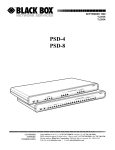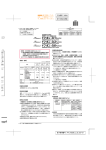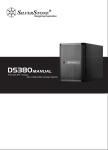Download Blackbox PSD-4/PSD-8分路器
Transcript
Blackbox PSD-4/PSD-8分路器 Blackbox PSD-4/PSD-8分路器作为可编程共享设备,可在异步或同步 多点环境下使4路(TL304A)或8路(TL305A)调制解调器或终端共享一台主调 制解调器、多路复用器或计算机端口。 (异步和同步设备不能混在同一个 PSD)。 ● 主通道:主通道并行向所有子通道播送信息。 ● 子通道 子通道通过竞争来占用主通道,而竞争是由 RTS/ DCD(请求发送/数据载 波检测)或数据转换(带可选)来实现的。当子通道是活动的,子通道的发送数 据和控制信号被连接到主通道。当 RTS/ DCD 下降、数据转换停止或 16 空闲 位被接收时,PSD 将断开连接并监视其他子通道。可以手动禁用或通过前面板 按钮自动禁用子通道。如果某个子通道连续播送并保持活跃的时间比配置的时间 长,PSD 将自动禁用该子通道。前面板 LED 指示灯亮起时,表明子通道已经 自动禁用。当 RTS/ DCD 下降或 16 空闲位从所连接的设备发送给子通道时, 子通道将会被重置。 ● 时钟模式:三个时钟模式支持:内时钟、主通道外时钟、子通道1外时钟。 ● 缓冲器 内置的缓冲器能够补偿调制解调器时钟之间的相位差。当 PSD 连接的设备 不能接受一个外部时钟时,PSD-8上的额外缓冲选项就可以被激活。比如,DDs (美国)或其他数字线和调制解调器,可以不被设置为外部时钟。这个附加缓冲 器补偿了该 PSD 时钟和子通道时钟之间的相位差。 了解更多 Blackbox PSD-4/PSD-8分路器 SEPTEMBER 1998 TL304A TL305A PSD-4 PSD-8 CUSTOMER SUPPORT INFORMATION Order toll-free in the U.S.: Call 877-877-BBOX (outside U.S. call 724-746-5500) FREE technical support 24 hours a day, 7 days a week: Call 724-746-5500 or fax 724-746-0746 Mailing address: Black Box Corporation, 1000 Park Drive, Lawrence, PA 15055-1018 Web site: www.blackbox.com • E-mail: [email protected] FCC STATEMENT FEDERAL COMMUNICATIONS COMMISSION AND INDUSTRY CANADA RADIO FREQUENCY INTERFERENCE STATEMENTS This equipment generates, uses, and can radiate radio-frequency energy, and if not installed and used properly, that is, in strict accordance with the manufacturer’s instructions, may cause interference to radio communication. It has been tested and found to comply with the limits for a Class A computing device in accordance with the specifications in Subpart B of Part 15 of FCC rules, which are designed to provide reasonable protection against such interference when the equipment is operated in a commercial environment. Operation of this equipment in a residential area is likely to cause interference, in which case the user at his own expense will be required to take whatever measures may be necessary to correct the interference. Changes or modifications not expressly approved by the party responsible for compliance could void the user’s authority to operate the equipment. This digital apparatus does not exceed the Class A limits for radio noise emission from digital apparatus set out in the Radio Interference Regulation of Industry Canada. Le présent appareil numérique n’émet pas de bruits radioélectriques dépassant les limites applicables aux appareils numériques de la classe A prescrites dans le Règlement sur le brouillage radioélectrique publié par Industrie Canada. 1 PSD-4 AND PSD-8 INSTRUCCIONES DE SEGURIDAD (Normas Oficiales Mexicanas Electrical Safety Statement) 1. Todas las instrucciones de seguridad y operación deberán ser leídas antes de que el aparato eléctrico sea operado. 2. Las instrucciones de seguridad y operación deberán ser guardadas para referencia futura. 3. Todas las advertencias en el aparato eléctrico y en sus instrucciones de operación deben ser respetadas. 4. Todas las instrucciones de operación y uso deben ser seguidas. 5. El aparato eléctrico no deberá ser usado cerca del agua—por ejemplo, cerca de la tina de baño, lavabo, sótano mojado o cerca de una alberca, etc.. 6. El aparato eléctrico debe ser usado únicamente con carritos o pedestales que sean recomendados por el fabricante. 7. El aparato eléctrico debe ser montado a la pared o al techo sólo como sea recomendado por el fabricante. 8. Servicio—El usuario no debe intentar dar servicio al equipo eléctrico más allá a lo descrito en las instrucciones de operación. Todo otro servicio deberá ser referido a personal de servicio calificado. 9. El aparato eléctrico debe ser situado de tal manera que su posición no interfiera su uso. La colocación del aparato eléctrico sobre una cama, sofá, alfombra o superficie similar puede bloquea la ventilación, no se debe colocar en libreros o gabinetes que impidan el flujo de aire por los orificios de ventilación. 10. El equipo eléctrico deber ser situado fuera del alcance de fuentes de calor como radiadores, registros de calor, estufas u otros aparatos (incluyendo amplificadores) que producen calor. 11. El aparato eléctrico deberá ser connectado a una fuente de poder sólo del tipo descrito en el instructivo de operación, o como se indique en el aparato. 12. Precaución debe ser tomada de tal manera que la tierra fisica y la polarización del equipo no sea eliminada. 13. Los cables de la fuente de poder deben ser guiados de tal manera que no sean pisados ni pellizcados por objetos colocados sobre o contra ellos, poniendo particular atención a los contactos y receptáculos donde salen del aparato. 14. El equipo eléctrico debe ser limpiado únicamente de acuerdo a las recomendaciones del fabricante. 15. En caso de existir, una antena externa deberá ser localizada lejos de las lineas de energia. 16. El cable de corriente deberá ser desconectado del cuando el equipo no sea usado por un largo periodo de tiempo. 17. Cuidado debe ser tomado de tal manera que objectos liquidos no sean derramados sobre la cubierta u orificios de ventilación. 18. Servicio por personal calificado deberá ser provisto cuando: A: El cable de poder o el contacto ha sido dañado; u B: Objectos han caído o líquido ha sido derramado dentro del aparato; o C: El aparato ha sido expuesto a la lluvia; o D: El aparato parece no operar normalmente o muestra un cambio en su desempeño; o E: El aparato ha sido tirado o su cubierta ha sido dañada. 2 TRADEMARKS TRADEMARKS USED IN THIS MANUAL AS/400 is a registered trademark of International Business Machines Corporation. Any other trademarks mentioned in this manual are acknowledged to be the property of the trademark owners. 3 PSD-4 AND PSD-8 1. Specifications Number of Sub-Channels — PSD-4: 4 PSD-8: 8 Channel Configuration — Lowest Priority: Highest Priority: Sub-channel 1 PSD-4: Sub-channel 4 PSD-8: Sub-channel 8 Sub-Channel Selection — RTS/DCD on or data transitions (strap-selectable) Sub-Channel Deselection — RTS/DCD off or 16 bits of idle data (strap-selectable) Sub-Channel Dialing — Manual: Press in the front-panel pushbutton switch Automatic: If a sub-channel stays connected for more than a pre-set period of time (strap-selectable—1.7, 13.5, or 108), the PSD automatically disables it Clock Source — Internal, external from main channel, or external from sub-channel 1 Data Rates — Asynchronous: Synchronous: Up to 19.2 kbps Internal Clock: 1.2, 2.4, 4.8, 7.2, 9.6, 14.4, or 19.2 kbps External Clock: Up to 19.2 kbps Connectors — IEIA RS-232-C/CCITT V.24; DCE or DTE (strap-selectable) Controls — Front-panel SUB-CHANNEL DISABLE pushbutton switch for each sub-channel; rear-panel POWER rocker switch; rear-panel 110/220 VAC selector LED Indicators — POWER: DATA: Lights when the unit is receiving AC power Lights when data is broadcast from the main channel to the sub-channels ACTIVITY: Lights when the sub-channel accesses the main channel AUTOMATIC: Lights when sub-channel has been automatically disabled Temperature — 32 to 122°F (0 to 50°C) Humidity — 30 to 90%, non-condensing Power — 110/220 VAC switchable + 10% Size — I1.7"H x 17"W x 8.2"D (4.3 x 43.1 x 20.8 cm) Weight — 4.4 lb (2.0 kg) 4 CHAPTER 2: Introduction 2. Introduction The Programmable Sharing Device enables up to 4 (TL304A) or 8 (TL305A) modems or terminals to share a master modem, multiplexor, or computer port in an asynchronous or synchronous multipoint environment. (Asynchronous and synchronous equipment cannot be mixed on the same PSD.) MAIN CHANNEL The main channel transmits information to all sub-channels in parallel. SUB-CHANNELS Sub-channels contend to transmit to the main channel by activating RTS/DCD (Request to Send/Data Carrier Detect) or by data transitions (strap-selectable). When the sub-channel is active, the sub-channel’s transmit data and control signals are connected to the main channel. When RTS/DCD drops, data transitions stop, or 16 idle bits are received, the PSD will disconnect and monitor other sub-channels. Sub-channels can be disabled either manually by front-panel pushbuttons or automatically. If a sub-channel is streaming and staying active for longer than a configured amount of time, the PSD will automatically disable that sub-channel. A front-panel LED will illuminate to indicate that the sub-channel has been automatically disabled. The sub-channel will be reset when RTS/DCD drops or 16 idle bits are transmitted to it from the attached device. CLOCK MODES Three clock modes are supported: internal, external from the main channel, or external from sub-channel 1. BUFFER A built-in-buffer compensates for phase differences between the clocks of modems connected to the subchannels and the PSD main-channel transmit clock. An extra-buffer option on the PSD-8 can be activated when the PSD is connected to equipment that cannot accept an external clock. Examples include DDs (United States) or other digital lines and modems that cannot be set to an external clock. This additional buffer compensates for phase differences between the PSD clock and sub-channel clock(s). RS-232 Cable RS-232 Cable Controllers Modem Dialup Line Modem PSD-4 Modem Leased Line Modem AS/400® CSU/DSU Leased Line CSU/DSU Figure 1. The Programmable Sharing Device allows multiple devices to share a master port. 5 PSD-4 AND PSD-8 3. Installation 3.1 Choosing a Site • The PSD must be installed within five feet (1.5 m) of a grounded AC outlet. • The PSD must be within 50 feet (15 m) of the equipment that will be attached to the main channel and each sub-channel. • Allow 36 inches (91 cm) frontal clearance for operating and maintenance accessibility. • Allow four inches (10 cm) rear-panel clearance for the power and interface cables. • Side-panel brackets can be used to install the unit in a 19" rack. (The brackets can be removed without harming the PSD.) 3.2 Configuring the PSD Printed Circuit Board Table 1 on the following page explains each of the configurable jumpers or switches on the PSD printed circuit board. Figures 3 and 4 show the locations of each of the jumpers and switches for the PSD-4 and PSD-8. There are two EXT. BUFFER switches on the PSD-8. These are extra buffers—not external buffers. Use the extra buffers when the PSD is connected to equipment that cannot accept an external clock from the PSD. The extra buffers compensate for phase differences between clocks. There are many applications where this might be necessary, but one example would be where multiple CSU/DSUs (each attached to its own leased line that provides clocking) are connected to the PSD. Switch S1 controls the buffer for sub-channels 1 through 4, and switch S2 controls the buffer for sub-channels 5 through 8. POWER: Lights when the unit is receiving AC power DATA: Lights when data is broadcast from the main channel to the sub-channels ACTIVITY: Lights when the sub-channel accesses the main channel. SUB-CHANNEL DISABLE: Press in the push button to manually disable a sub-channel. AUTOMATIC: Lights when subchannel has been automatically disabled. Figure 2. The front panels of the PSD-4 (top) and the PSD-8 (bottom). 6 CHAPTER 3: Installation Table 1. Printed Circuit-Board Switch and Strap Settings Possible Settings Factory Setting MAIN DCE/DTE switch DTE DCE DTE Determines the PSD’s Main Channel interface as either DTE (straight connection to a modem) or as DCE (straight connection to a computer or terminal). Sub-channel DCE/DTE switches DTE DCE DTE Determines the PSD’s sub-channel interface as either DTE or DCE. 19.2 14.4 9.6 7.2 4.8 2.4 1.2 CLK 1 9.6 Stap Identity DATA RATE (kbps) (rotary switch) Location BR1 Function Selects the PSD’s internal data rate or external clock from sub-channel 1. NOTE: When using CLK 1 mode, the main channel cannot be connected to a modem working in internal clock. Chas. GND J1 CONNECT DISCONNECT The CONNECT setting connects signal ground DISCONNECT to chassis ground. The DISCONNECT setting isolates them. PIN 24 DIS J1A ENABLE (jumpered) DISABLE (NO jumper) ENABLE Exits main channel when PIN 24 is disabled. TIME OUT J2 1.7 13.5 108 DISABLE 108 Selects the time-out period (in seconds) after which the PSD will automatically disable the sub-channel. Selecting DISABLE will stop the PSD from automatically disabling any sub-channels. CONTENTION J5 RTS DATA RTS Determines the sub-channel selection and deselection. FORMAT J6 ASYNC SYNC SYNC CLOCK J7 NORMAL FROM EXT DTE NORMAL EXT. BUFFER (PSD-8 only) S1 S2 ON OFF OFF Selects the data format. Determines the source of the clock for synchronous data. Set to NORMAL for internally derived clock. Set to FROM EXT DTE for externally dermined clock from a connected DTE. Activates or deactivates the extra buffer. 7 PSD-4 AND PSD-8 Figure 3. The Printed Circuit Board of the PSD-4. Figure 4. The Printed Circuit Board of the PSD-8. 8 CHAPTER 3: Installation 3.3 System Synchronization ASYNCHRONOUS MODE Strap the J6 jumper over the ASYNC pins. All attached equipment must be asynchronous. Turn the BIT RATE rotary switch (BRI) to the correct system speed. No other adjustments to the PSD are necessary. SYNCHRONOUS MODE Strap the J6 jumper over the SYNC pins (this is the factory-default setting). All attached equipment must be synchronous. There are four ways to synchronize the system: 1. Synchronization on the PSD’s internal clock. • Main channel: Equipment attached to the main channel should be set to external clock. • Sub-channel: Equipment attached to the sub-channels should be set to external clock. • BIT RATE rotary switch: Set BRI to the correct system speed. 2. Synchronization on the equipment attached to the main channel. • Main channel: Equipment attached to the main channel should be set to internal clock. • Sub-channels: Equipment attached to the sub-channels should be set to external clock. • BIT RATE rotary switch: Set BRI to the correct system speed. • Jumper J7: If the equipment attached to the main channel is DCE, strap to NORMAL. If the equipment is DTE, strap to FROM EXT DTE. 3. Synchronization on the equipment attached to sub-channel 1. • Main channel: Equipment attached to the main channel should be set to external clock. • Sub-channel 1: Equipment attached to sub-channel 1 should be set to internal clock. • Sub-channel 2 through 8: Equipment attached to the sub-channels 2 through 8 should be set to external clock. • BIT RATE rotary switch: Set BRI to position 7 (CLK1). • Jumper J7: If the equipment attached to the sub-channel 1 is DCE, strap to NORMAL. If the equipment is DTE, strap to FROM EXT DTE. NOTE: Synchronization on sub-channel 1 is not recommended when the device attached to sub-channel 1 operates in switched carrier mode. This will cause fluctuations in clock frequency and phase. 4. Synchronization on equipment attached to any sub-channel (PSD-8 only). • Main channel: Equipment attached to the main channel can be set to internal or external clock. • Sub-channels: Equipment attached to the sub-channels can be set to internal or external clock. 9 PSD-4 AND PSD-8 • BIT RATE rotary switch: Set BRI to the correct system speed. • EXT. BUFFER: If any of the devices connected to the sub-channels numbered 1 through 4 are set to internal clock, then switch S1 should be ON. If any of the devices connected to the sub-channels numbered 5 through 8 are set to internal clock, then switch S2 should be ON. • Jumper J7: If the equipment attached to the sub-channel 1 is DCE, strap to NORMAL. If the equipment is DTE, strap to FROM EXT DTE. 3.4 AC Power On the rear panel of your unit, locate the 110/220 VAC selector. Set the selctor to match your main power source. After configuration is complete and the cover to the unit is replaced, plug the power cord into the PSD. Plug the other end into a grounded AC power jack. NOTE: There is a 0.25A slow-blow fuse in your unit. Do not replace this fuse with a repaired fuse. Do not short-circuit the fuse holder. Turn the POWER rocker switch on. 10 CHAPTER 4: Operation and Troubleshooting 4. Operation and Troubleshooting 4.1 Operation Turn on the rear-panel POWER rocker switch. The front-panel POWER LED will light. The PSD operates automatically. Except for manually disabling a sub-channel, you will not need to attend to the PSD. 4.2 Changing Setting During Operation If you have to reconfigure the PSD for a different type of operation, turn off the PSD and unplug it from its AC power source before taking off the cover to change settings. 4.3 Troubleshooting POWER SUPPLY If the unit is attached to an AC power source and the green Power LED does not light up, check the following: • Make sure the rear-panel rocker switch is on and is lit. • Verify that the 110/220 selector is set correctly. • Unplug the unit and check the fuse (see Figure 5 for location of the fuse). • Remove the top cover and verify that the 4-pin power connector is attached to the transformer on the printed circuit board (PSD-8 only). PSD MALFUNCTION If the Power LED is lit, but the PSD is not functioning, unplug your unit. Take off the cover and check the following: • Verify that all the DCE/DTE switches are set according to the data-system requirements. • Double-check each of your strap settings. • Visually inspect the large chips labeled RJ-006. Make sure that they are securely attached to the printed circuit board. 11 PSD-4 AND PSD-8 FUSE POWER: Rocker switch to turn AC power on or off 110/220 VAC Selector: Align either 110 or 220 with the arrow. SCREWS: Loosen these screws to take off the cover of the PSD. Figure 5. The back panels of the PSD-4 (top) and the PSD-8 (bottom). 12 CHAPTER 5: Technical Guide 5. Technical Guide 5.1 Control Signals MAIN CHANNEL CONTROL SIGNALS RTS (DCD) • In RTS/DCD contention mode: follows RTS (DCD) of the selected sub-channels. • In Data Contention mode: ON if one of the sub-channels RTS (DCD) is ON. CTS On only when the CTS signals of all active sub-channels are ON. A sub-channel is active if it is connected to a modem and the DSR signal is ON (enables connection of dialup modems to the PSD). DSR (DTR) ON if one of the sub-channel’s DTR (DSR) is ON. SUB-CHANNEL CONTROL SIGNALS RTS (DCD) • Follows the main channel RTS (DCD) (unless the sub-channel is disabled). CTS • In RTS contention mode: selected sub-channel follows DTS signal of main channel. • In Data Contention mode: sub-channel receives CTS from main channel immediately after it raises RTS (unless the sub-channel is disabled). DSR (DTR) Follows the main channel DSR (DTR). 5.2 Block Diagrams Figures 6 through 9 illustrate the flow of data and control signals in the PSD, in different DTE/DCE configurations: Figure Number Main Channel Configuration SubChannel Configuration 6 7 8 9 DTE DTE DCE DCE DCE DTE DCE DTE 13 PSD-4 AND PSD-8 Figure 6. Main Channel DTE with Sub-Channel DCE. Figure 7. Main Channel DTE with Sub-Channel DTE. 14 CHAPTER 5: Technical Guide Figure 8. Main Channel DCE with Sub-Channel DCE. Figure 9. Main Channel DCE with Sub-Channel DTE. 15 © Copyright 1998. Black Box Corporation. All rights reserved. 1000 Park Drive • Lawrence, PA 15055-1018 • 724-746-5500 • Fax 724-746-0746






















